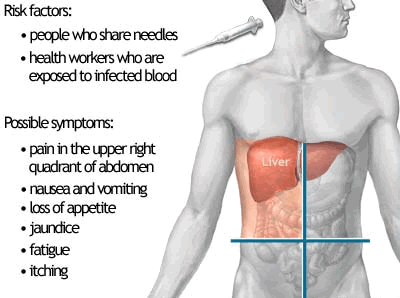Acute
Hepatitis C as a Sexually Transmitted Infection in HIV Positive
Men
 |
 |
 |
 |
 |
 |
 |
| SUMMARY:
Sexual transmission of hepatitis C virus (HCV) among
HIV positive men who have sex with men has now been
recognized for a decade, occurring in cities in Europe,
North America, and Australia. Since acute HCV outbreaks
occur almost exclusively among men with HIV, being
HIV positive probably plays a critical role, according
to the authors of a review article in the July
31, 2010 issue of AIDS. |
|
 |
 |
 |
 |
 |
 |
 |
By
Liz Highleyman
 Thijs
van de Laar from the Amsterdam Public Health Service and colleagues
presented an overview of acute HCV infection among gay/bisexual
men with HIV, including epidemiology, risk factors, natural
history, disease progression, and challenges of management.
The review was based on published studies identified through
a MEDLINE search and relevant conference abstracts.
Thijs
van de Laar from the Amsterdam Public Health Service and colleagues
presented an overview of acute HCV infection among gay/bisexual
men with HIV, including epidemiology, risk factors, natural
history, disease progression, and challenges of management.
The review was based on published studies identified through
a MEDLINE search and relevant conference abstracts.
HCV
Transmission
HCV
is usually transmitted through direct blood contact, for example,
via shared needles for injection drug use (IDU) or blood transfusions
before donated blood was screened. Due to common transmission
routes, an estimated 4-5 million people -- or approximately
one-third of people with HIV
-- are HIV/HCV
coinfected.
Sexual
transmission of HCV was traditionally thought to be uncommon
(less than 1%) based on studies of monogamous heterosexual couples.
Early cross-sectional studies found a relatively high HCV prevalence
rate among men who have sex with men (MSM), but these often
did not take into account injection drug use.
Since
2000, however, several outbreaks of acute hepatitis C among
HIV positive gay and bisexual men who denied injection drug
use have been reported, first in the U.K., then in other large
cities in France, Germany, and the Netherlands, followed by
Australia, the U.S., and Canada.
|
ACUTE
HEPATITIS C
|
 |
"Given
the burden of liver disease, in particular HCV, on the morbidity
and mortality in HIV patients in the era of combination antiretroviral
therapy, the rapid and significant rise in the incidence of
HCV in the HIV-infected MSM population in high-income countries
is alarming," the review authors wrote. "This relates
to a significant change in the epidemiology of HCV that has
occurred, with HCV emerging as a sexually transmitted infection
within this population."
In the Netherlands, for example, a biannual survey among sexually
transmitted infection (STI) clinic attendees showed an increase
in HCV prevalence among HIV positive MSM from 1%-4% before
2000 to 15% in 2007 and 21% in 2008. HCV prevalence among HIV
negative gay/bisexual men, however, remains comparable to that
of the general population.
Most cases of acute hepatitis C among MSM in Europe involve
hard-to-treat HCV genotypes 1a and 4d, the latter of which is
otherwise uncommon in Europe and the U.S. Genetic sequencing
has revealed closely
related virus strains coinciding with sexual networks.
Evolutionary
analysis "suggests multiple independent introductions of
HCV into the MSM community, some as early as the 1980s,"
the authors surmised. "Most likely, these strains were
introduced from the IDU population." They noted that the
recent increase in HCV sexual transmission coincides with a
rise in sexual risk behavior and increased STI rates in the
era of effective combination ART, some of which is due to serosorting,
or HIV positive men have unprotected sex with other positive
men.
Research to date indicates that HCV transmission is associated
with a
variety of sexual practices -- including fisting, unprotected
anal intercourse, use of shared sex toys, group sex, and sex
while on drugs -- though specific activities vary
from study to study. Other risk factors include non-injection
drug use and presence of other sexually transmitted diseases.
These studies show that "most MSM with HCV report a combination
of various, potentially high-risk, sexual and drug practices,"
the authors wrote. "The interaction between sex and drugs
is complex, and many of these factors are highly correlated
and difficult to disentangle."
"Given this occurs almost exclusively in HIV-infected MSM,
HIV probably has a critical role mediated either through behavioral
and/or biological factors," they stated. "It is not
yet known whether lower CD4 cell count increases the risk of
acquiring HCV, but the fact that many MSM with acute HCV have
relatively preserved CD4 cell counts suggests this may not be
a critical factor."
Disease
Progression and Treatment
Turning to hepatitis C disease progression in this population,
they wrote, "The natural history of HCV is determined by
host-viral interactions, which are perturbed in HIV coinfection,
resulting in accelerated liver fibrosis, higher HCV loads, and
poorer responses to interferon-based therapy when compared with
HCV monoinfection."
While about 25% of HIV negative individuals spontaneously clear
HCV without treatment, this is less likely among people with
HIV -- as low as 5% in one study -- perhaps due to reduced T-cell
responses. HIV/HCV coinfection is associated with more rapid
liver fibrosis. Some studies indicate that progression
is especially fast among people who already have HIV at
the time of HCV infection, but other data are conflicting.
Hepatitis
C treatment using pegylated interferon (with or without ribavirin)
is quite successful during acute HCV infection. Because they
receive regular liver function tests to monitor drug toxicity,
people with HIV are more likely to have HCV infection diagnosed
during the acute stage. Acute
hepatitis C cure rates among HIV positive people are around
60%-80% in most studies.
Optimal
timing and duration of therapy for acute HCV infection is not
well defined, but most experts recommend waiting 12 weeks to
see if spontaneous clearance will occur. Most favor combination
therapy over pegylated interferon monotherapy and a treatment
duration of 24 weeks for coinfected patients.
"Targeted
prevention such as raising awareness, regular screening and
treatment of acute and chronic infections are needed to stop
the further spread among MSM," the review authors concluded.
"It is clear that a message of 'safe sex' through condom
use during anal intercourse could be provided, but given the
practice of negotiated unprotected sex among HIV-infected MSM
might not be accepted. In addition, it may not cover practices
that increase risk of blood-to-blood contact (e.g. fisting).
Furthermore, MSM population needs to be informed that reinfection
is an ongoing risk, given the recent
reports of HCV reinfection following successful treatment
and documented clearance of HCV."
Cluster
of Infectious Diseases, Public Health Service, Amsterdam, Netherlands;
Viral Hepatitis Clinical Research Program, National Centre for
HIV Epidemiology and Clinical Research, University of New South
Wales, Sydney, Australia; Department of Internal Medicine, Centre
for Infection and Immunity Amsterdam, Academic Medical Centre,
University of Amsterdam, Amsterdam, Netherlands; St. Vincent's
Clinical School, Faculty of Medicine, University of New South
Wales, Sydney, Australia.
8/20/10
Reference
TJ
van de Laar, GV Matthews, M Prins, and M Danta. Acute hepatitis
C in HIV-infected men who have sex with men: an emerging sexually
transmitted infection. AIDS 24(12): 1799-1812 (Abstract).
July 31, 2010.
